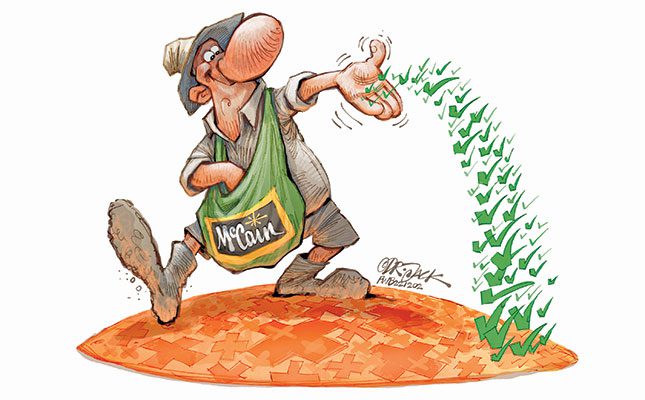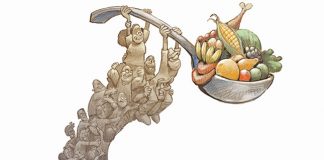
World Food Day is an important day to drive awareness of the plight of hunger and malnutrition. People come together to pledge their commitment and offer solutions to eradicate world hunger by 2030.
According to the World Economic Forum, over 20% of Africa’s population, or 278 million people across the continent, suffer from chronic hunger.
Climate change, political and economic instability, inflationary pressures and soaring food prices have resulted in the threat of starvation in many African countries. Food price shocks come when food security has already been under severe stress following the COVID-19 pandemic.
In the aftermath of the pandemic, world hunger increased substantially. Estimates from Unicef’s 2021 edition of its report, The State of Food Security and Nutrition around the World, reveal that as many as 161 million people suffered from starvation between 2019 and 2020, bringing the number of people who faced food insufficiency to 811 million.
In other words, about one in 10 people went to bed without enough nutrition in the first year of the COVID-19 pandemic.
Stabilisation of food prices requires a concerted effort from government and the private sector to work together and rethink how agriculture and local food systems are designed in order to become more resilient to climate change and socio-economic pressures.
Southern Africa continues to grapple with measures to contain unprecedented inflation amid risks of a new recession. Weather conditions in key production regions have fuelled further uncertainty in agricultural commodity markets, sending prices to record levels.
To make matters worse, growing food through traditional industrial degenerative methods has devastated our soil. Forecasts have predicted that, at the current rate, global topsoils will be depleted in 60 years, while studies have proved that conventional industrial agriculture contributes up to 25% of the emissions driving the climate crisis, according to a report published in 2021 by the Regenerative Organic Alliance.
The Global Food Security Index 2022 has shown that unless something is done swiftly, we shall continue to experience food insecurity. The index revealed that agricultural growth was expected to be 5% this year, a much slower rate than in 2021, as spiralling input costs offset much of the projected revenue gains in field crops and animal products. In contrast, prices in many horticultural industries are coming under increased pressure.
A drastic weakening in the ability to feed global populations and fund food safety nets is compounded by intrinsic and deep-rooted environmental problems, which require complicated solutions that take time and money to resolve. But this won’t necessarily help solve Africa’s current food crisis with its unique challenges and financial limitations; African solutions are needed.
There is huge potential in empowering people in enterprise supplier development with land and water resources that are not utilised optimally. This is an option that can result in potential financial and social economic benefits for communities. Community projects can work.
New ways of thinking about farming and food security are needed now more than ever, with resolutions that benefit everyone, including the soil, climate and communities.
Regenerative agriculture
One medium-term solution lies in regenerative agriculture (RA). This approach goes back to basics, where the premise is working with nature rather than against it. An ecosystem-based approach, it builds soil biology, drives minerals into the earth and works to improve natural water cycles without using harmful chemicals, over-ploughing or continuous grazing.
As such, it has a positive impact on soil health, ensures adaptation to climate change, and produces positive effects on biodiversity.
It also results in improved food quality, higher yields, and sustainably reduced synthetic inputs. McCain is spearheading RA through its Farm of the Future initiative, based in Lichtenburg. This uses holistic land management that leverages the power of photosynthesis in plants to close the carbon cycle and build soil health, crop resilience and nutrient density.
The results are improved soil biota diversity and health, greater biodiversity above and
below the soil surface, higher water-holding capacity, and the sequestering of carbon at greater depths. This in turn helps to lower climate-damaging levels of atmospheric carbon dioxide and improve soil structure to reverse anthropogenic soil loss.
RA is both a conservation and rehabilitation approach to food and farming. It focuses on regenerating topsoil, increasing biodiversity, improving the water cycle, enhancing ecosystem services, supporting biosequestration, increasing resilience to climate change, and strengthening the health and vitality of farm soil.
RA agriculture is based on creating a balanced ecosystem that restores organic matter to the soil to increase its total nutrient load. The practice uses crop rotation to ensure permanent ground cover to improve soil fertility and nutrient levels if nitrogen-fixing crops are included in the rotation.
Crop rotation and rotational animal grazing also enable soil nutrients to recover between growing and grazing periods, further enhancing nutrient load and cycling.
This approach to sustainable farming is shaped via four key strategies. First, reducing carbon dioxide emissions per ton from potato farming, storage and freight by 25% by 2030, helping to mitigate climate change.
Second, enabling sustainable water use by improving use efficiency by 15% by 2025 and driving water-use best practices across all farms.
Third, promoting good agricultural practices related to food safety, traceability, environmental sustainability, biodiversity and soil health.
And lastly, using agricultural technologies and innovations in RA practices and sharing these insights and learnings.
RA is needed to ensure that our food systems become more sustainable. Now is the time to focus on close collaboration and embrace crop protection solutions and agricultural practices to empower farmers so that they can continue to feed Africa’s people.
The views expressed in our weekly opinion piece do not necessarily reflect those of Farmer’s Weekly.











